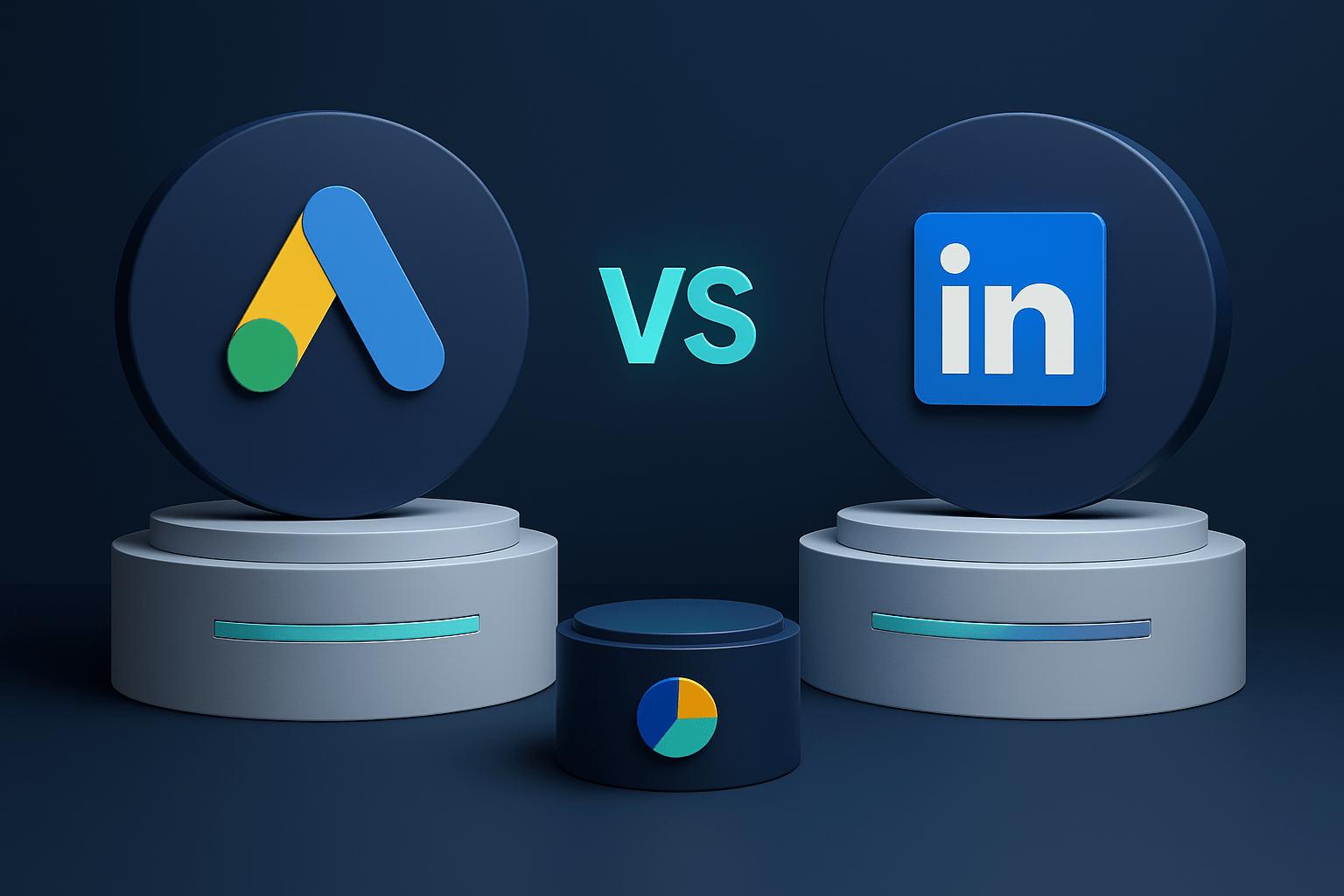Pioneering
Accounting
Acquisition
accountingprospects.com/blogs
In today's digital marketing landscape, B2B companies face a critical decision when allocating their advertising budgets: YouTube or LinkedIn? Both platforms offer powerful advertising capabilities, but they serve different purposes in the B2B lead generation ecosystem. This comprehensive comparison examines the key factors that influence ROI—including cost structures, targeting precision, creative formats, and lead quality—to help marketing decision-makers invest their resources where they'll generate the greatest impact.
1. Cost Per Click (CPC): Budget Implications for Each Platform
The cost difference between YouTube and LinkedIn advertising represents one of the most significant factors in platform selection. YouTube Ads, operating through the Google Ads platform, typically deliver substantially lower cost-per-click rates compared to LinkedIn's advertising ecosystem.
According to GrowLeads' 2025 analysis, YouTube's average CPC ranges from $0.50-$2.00 for most B2B industries, while LinkedIn averages $5.50-$13.00 per click. This price differential stems from Google's vast scale and auction system sophistication, which creates more competitive bidding environments that moderate prices.
- YouTube cost advantage: Lower acquisition costs allow for wider testing and broader reach
- LinkedIn premium: Higher CPCs often reflect the platform's professional audience and precision targeting
- Budget implications: YouTube can stretch limited budgets further, while LinkedIn requires more significant investment
- ROI consideration: Raw CPC comparisons don't account for conversion quality differences
While the cost differential is substantial, research from Vendy Steinberga suggests that companies must consider the complete conversion path and lead value rather than focusing exclusively on acquisition costs.
2. Targeting Capabilities: Precision vs. Scale
The targeting mechanisms between the two platforms represent fundamentally different approaches to audience segmentation. LinkedIn's targeting is built around professional identity, while YouTube leverages Google's vast behavioral and interest data.
LinkedIn's targeting infrastructure allows marketers to filter audiences based on specific professional attributes that are uniquely valuable in the B2B context:
- Job title and function: Target specific roles within organizations
- Company size and industry: Filter by organization type and scale
- Seniority level: Reach decision-makers or influencers
- Skills and educational background: Connect with specific professional competencies
- Account-based marketing: Target specific organizations by name
YouTube (via Google Ads) offers different but equally powerful targeting options that emphasize behavior and intent:
- Custom intent audiences: Target users based on their search behavior and research patterns
- Custom affinity audiences: Reach viewers with specific interests relevant to your B2B solution
- Remarketing capabilities: Re-engage website visitors, app users, or past video viewers
- Similar audiences: Expand reach to users who resemble your current customers
According to HawkSEM, LinkedIn's targeting precision makes it especially valuable for highly specialized B2B offerings or account-based marketing strategies. Conversely, YouTube excels at discovering new potential customers who haven't yet engaged with your brand but match behavioral patterns of your ideal buyers.
3. Creative Format Comparison: Video Dominance vs. Professional Presentation
The creative formats available on each platform fundamentally shape how messages are delivered and received. YouTube, as a video-first platform, naturally privileges visual storytelling, while LinkedIn offers a mix of formats designed for professional engagement.
YouTube's video ad formats include:
- Skippable in-stream ads: Full-featured videos that play before, during, or after other content
- Non-skippable in-stream ads: Shorter (15-20 second) mandatory viewing spots
- Bumper ads: Six-second non-skippable messages for brand awareness
- Video discovery ads: Promoted videos appearing in search results and recommendations
- YouTube Shorts ads: Vertical video format for the platform's TikTok competitor
LinkedIn's advertising formats include:
- Sponsored Content: Native posts appearing in members' feeds
- Sponsored Messaging: Direct InMail communication to targeted professionals
- Text Ads: Simple right-rail and top-banner advertisements
- Dynamic Ads: Personalized ads using member data (profile photos, company information)
- Carousel Ads: Swipeable images for storytelling
- Video Ads: Native video content for the LinkedIn feed
As HubSpot's analysis highlights, YouTube's video-centric environment allows for more comprehensive storytelling, product demonstrations, and emotional appeals. LinkedIn's formats, while more limited in sensory engagement, benefit from appearing within a professional context where users are already thinking about business solutions and career advancement.
4. Lead Quality and Buyer Intent: Professional Mindset vs. Discovery Mode
Perhaps the most significant difference between the platforms lies in the typical user mindset and its impact on lead quality. LinkedIn users are generally in a professional context when encountering ads, while YouTube viewers may be in various mental states ranging from entertainment to educational research.
According to WordStream's research, LinkedIn leads demonstrate several distinguishing characteristics:
- Higher intent alignment: Users are already in a professional mindset
- More accurate data: Professional profiles tend to contain current, accurate information
- Greater decision-making authority: More effective at reaching actual decision-makers
- Shorter sales cycles: Often require less nurturing to convert
YouTube leads present a different profile, as outlined by Instapage:
- Higher volume potential: Greater reach creates more top-of-funnel opportunities
- More diverse intent: Captures users across multiple mindsets and research stages
- Greater need for nurturing: Typically requires more touchpoints before conversion
- Better for complex value propositions: Video format allows for more detailed explanation
While LinkedIn typically generates leads that are closer to purchase-ready, Foundation Inc's comparison found that YouTube's combination of intent signals and engagement metrics can identify high-value prospects who may not yet realize they need your solution—creating opportunities for thought leadership and category creation.
5. Platform Selection: Strategic Use Cases
Rather than viewing these platforms as competitors, sophisticated B2B marketers increasingly see them as complementary channels serving different stages of the buyer's journey. Understanding the ideal use cases for each platform is essential for optimal budget allocation.
YouTube Ads excel in these scenarios:
- Category education: Introducing new concepts or solutions to the market
- Complex value propositions: Products/services requiring detailed explanation
- Visual demonstrations: Solutions with strong visual components
- Broad awareness building: Reaching previously unaware potential customers
- Content amplification: Extending the reach of existing video content
LinkedIn Ads demonstrate strength in these applications:
- Account-based marketing: Targeting specific organizations and roles
- High-value conversions: Solutions with significant contract values
- Professional services marketing: B2B services requiring credibility and trust
- Direct response for known solutions: Products with established category awareness
- Executive-level targeting: Reaching C-suite and senior decision-makers
For many B2B organizations, the optimal approach involves using both platforms in coordination rather than choosing exclusively between them. YouTube builds broader awareness and educates the market, while LinkedIn captures active buyers among professionals already considering solutions.
6. Funnel Structure: Platform-Optimized Conversion Paths
Successful implementation of either platform requires tailoring the conversion funnel to match the platform's strengths and user expectations. The structure of effective lead generation funnels differs significantly between YouTube and LinkedIn.
Effective YouTube lead generation funnels typically follow this structure:
- Video ad engagement: Capture attention with problem-focused opening
- Value demonstration: Show solution capabilities and differentiation
- Landing page with expanded content: Provide more information and lead capture
- Lead magnet delivery: Offer valuable resources for contact information
- Email nurture sequence: Develop relationship through continued value delivery
- Sales conversation trigger: Convert nurtured leads to sales opportunities
LinkedIn lead generation funnels often employ this approach:
- Sponsored content exposure: Deliver targeted message in professional feed
- Native lead capture: Use LinkedIn's lead gen forms to reduce friction
- Direct value delivery: Provide immediate access to offered content/resource
- InMail follow-up: Personal outreach from sales or success team
- Connection request: Establish ongoing professional relationship
- Direct meeting scheduling: Convert qualified leads to conversations
A practical example of effective YouTube funnel execution can be seen in this case study video, which demonstrates how sequential messaging can move viewers from problem awareness to solution consideration through strategic video content.
7. Conclusion: Strategic Integration for Maximum Impact
The YouTube vs. LinkedIn comparison reveals that each platform offers distinct advantages that align with different marketing objectives and buyer journey stages. Rather than viewing this as a binary choice, sophisticated B2B marketers are increasingly integrating both platforms into comprehensive digital strategies.
Key takeaways for B2B marketers include:
- Budget allocation should follow funnel stage: YouTube for awareness and education, LinkedIn for consideration and decision
- Creative development requires platform specialization: Different formats and messaging approaches for each channel
- Testing across platforms reveals audience-specific insights: Messaging that resonates on one platform may not transfer to the other
- Conversion path optimization is platform-dependent: Align landing pages and offers with the originating platform
- Measurement frameworks must account for different attribution patterns: YouTube often influences conversions that occur later through other channels
By understanding the comparative strengths of these platforms and strategically deploying them in combination, B2B marketers can create integrated campaigns that guide prospects through each stage of the buyer's journey with the right message in the right format at the right time.
More in Marketing
loyal accounting clients.


